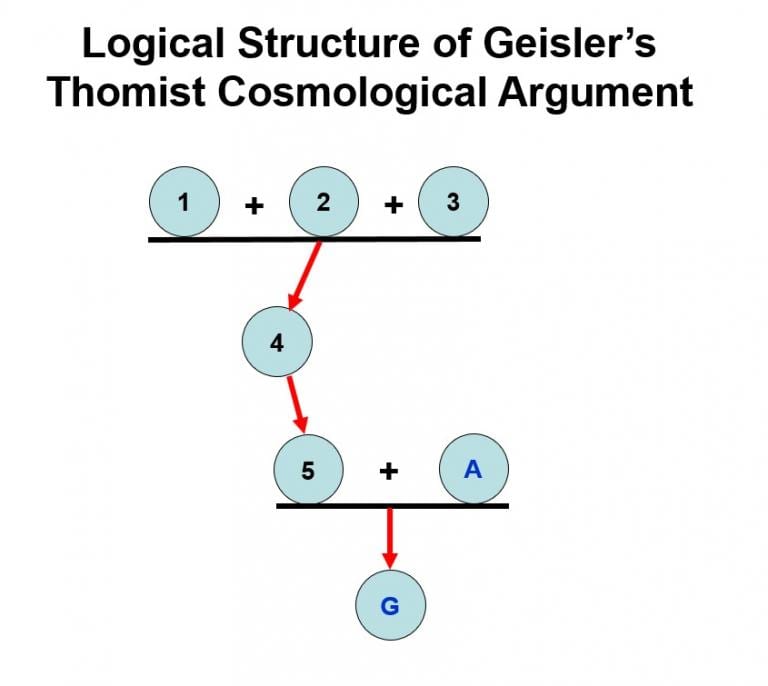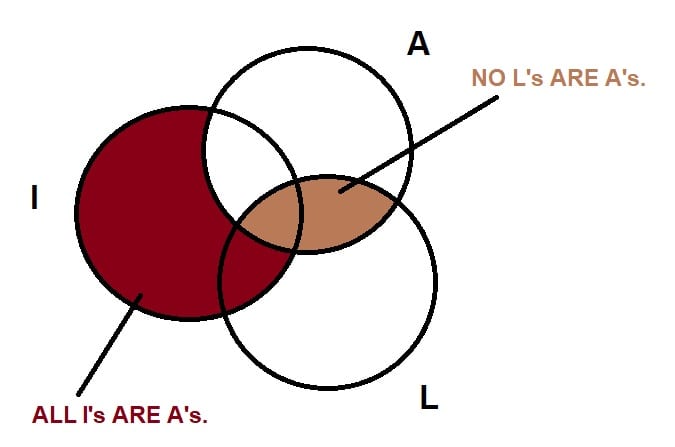The Unmoved Mover Argument – Part 10: Geisler’s Argument for Premise (2)
WHERE WE ARE
In his book When Skeptics Ask (hereafter: WSA), Norman Geisler presents his general version of a Thomist Cosmological Argument (hereafter: TCA). I analyze this argument in Part 2 of this series.
The first premise of Geisler’s TCA is this:
1. Finite, changing things exist. (WSA, p.18)
Geisler provides a very brief argument in support of (1) in WSA. In Part 4 of this series I showed that Geisler’s brief argument in support of (1) was a stinking philosophical TURD. It FAILS utterly and completely to support ANY part of premise (1).
In Part 5 of this series I clarified and analyzed a longer and more sophisticated argument by Geisler in support of just one part of premise (1) of TCA, an argument that is found in his much older book Philosophy of Religion (hereafter: PoR). This longer argument only supports the simple (and obviously true) claim that “Something exists”. In Part 6 of this series, I argued that this longer argument by Geisler FAILS.
In Part 7 of this series, I analyzed and evaluated Geisler’s first argument in PoR for the following claim:
21. Changing things exist.
I concluded that this first argument in PoR for (21) FAILS.
In Part 8 of this series, I analyzed Geisler’s second argument for claim (21), and then I began to evaluate the argument. But I repeatedly ran into problems with the argument, problems that could be fixed by making an unstated assumption explicit, or by clarifying the meaning of a premise, or by modifying a premise in order to make an inference in the argument logically valid. I ended up adding a number of premises, and modifying the statement of each of the original premises.
Because I have revised each of the three premises that Geisler provided in order to clarify them or to make the logical inferences valid, and because I have had to add five different unstated assumptions, also in order to make the logical inferences in this argument valid, it is no longer clear that this is Geisler’s argument. My thought, effort, and skills have gone into the construction of this argument, and it is significantly different from the argument that we started with. So, even if this turns out to be a solid deductive argument, that will not show that Geisler’s original argument was a solid deductive argument.
It is clear that Geisler’s second argument as originally stated was NOT a SOUND deductive argument, and that it FAILED as a deductively valid proof of the conclusion. But the enhanced version of Geisler’s second argument might have turned out to be a solid proof, so I evaluated this enhanced 2nd argument in Part 9 of this series. Here is the conclusion of the enhanced 2nd argument:
21a. Changing things exist right now.
Although I made several significant improvements to his argument, it still has a number of unclear and dubious premises, and some invalid inferences in the sub-arguments for key premises. Even the significantly enhanced version of Geisler’s second argument for the claim that “Changing things exist right now.” clearly FAILS. Geisler’s second argument for (21a) FAILS.
Since all three of Geisler’s attempts to support premise (1) of his Thomist Cosmological Argument, he has FAILED in his attempt to prove the existence of God.
GEISLER’S THOMIST COSMOLOGICAL ARGUMENT (TCA)
The second cosmological argument in When Skeptics Ask is Geisler’s generalized version of a Thomist cosmological argument (WSA, p. 18 & 19):
1. Finite, changing things exist.
2. Every finite changing thing must be caused by something else.
3. There cannot be an infinite regress of these causes.
THEREFORE:
4. [There is]…a first uncaused cause of every finite, changing thing that exists.
THEREFORE:
5. There is a present, conserving cause of the world.
A. IF there is a present, conserving cause of the world, THEN God exists.
THEREFORE:
G. God exists.
Here is the logical structure of TCA:
Since Geisler has FAILED to show that premise (1) is true, it seems unlikely that he will be able to prove that premise (2) or (3) are true, since those premises are controversial and dubious, whereas premise (1) was obviously true. But since premise (1) is obviously true, we should not reject TCA just because Geisler FAILED to prove that (1) is true. Since premise (1) seems to be obviously true, we should accept it, and examine the rest of this argument to see if the other premises are true, and if the inferences in the argument are all logically valid.
GEISLER’S SUPPORT FOR PREMISE (2) OF TCA
Here is premise (2) of TCA:
2. Every finite changing thing must be caused by something else. (WSA, p.18)
Geisler attempts to support premise (2) in just two sentences:
If it is limited and it changes, then it cannot be something that exists independently. If it existed independently, or necessarily, then it would have always existed without any kind of change. (WSA, p.18)
It seems foolish and pathetic to attempt to prove premise (2) in just two sentences, so it will be no surprise if this argument FAILS, like most of Geisler’s other apologetic arguments.
The second sentence provides a reason in support of the first sentence. Also, I take it that the term “necessarily” is supposed to be equivalent to the term “independently” in this context, so we can simplify by dropping the redundant term “necessarily”:
41. If a thing existed independently, then it would have always existed without any kind of change.
THEREFORE:
42. If a thing is limited and it changes, then it cannot be a thing that exists independently.
This is a bit sloppy, as Geisler often is in presenting his arguments. There is a shift from the past tense phrase “existed independently” in premise (41) to the present tense phrase “exists independently” in premise (42). So, it is unclear that this is a logically valid inference.
We can fix this problem by consistently using the present tense phrase in both premises:
41a. If a thing exists independently, then it would have always existed without any kind of change.
THEREFORE:
42. If a thing is limited and it changes, then it cannot be a thing that exists independently.
This inference seems OK. It might well be a logically valid inference. However, the logic is not completely clear. These statements are in the form of conditional statements (IF P, THEN Q), but they are both actually universal generalizations (ALL Xs ARE Ys). So, I will restate the premises as universal generalizations:
41b. ALL things that exist independently ARE things that have always existed without any kind of change.
THEREFORE:
42b. NO things that are limited and that change ARE things that exist independently.
There are three different categories that are referenced in the above argument:
I: things that exist independently
A: things that have always existed without any kind of change
L: things that are limited and that change
So, if we abbreviate by using the above categorical designations, we can see the logical structure of Geisler’s argument:
41c. ALL I’s ARE A’s.
Therefore:
42c. NO L’s ARE I’s.
Since one of the categories referenced in the conclusion is not referenced in the premise, this argument is NOT formally valid. The problem here is that there are logical relationships that Geisler is ASSUMING between these various categories. But we need to make those logical relationships EXPLICIT in order to determine what other ASSUMPTIONS are being made here, and to determine whether this argument can be restated in a way that is clearly a logically VALID argument.
One assumption that Geisler appears to be making is this:
NO things that are limited and that change ARE things that have always existed without any kind of change.
OR:
H. NO L’s ARE A’s.
This seems clearly to be true, to be a necessary truth. A thing that changes cannot have always existed without any kind of change.
So, if we add this necessary truth to the original argument, we might have an argument that is clearly logically valid:
41c. ALL I’s ARE A’s.
H. NO L’s ARE A’s.
Therefore:
42c. NO L’s ARE I’s.
This categorical syllogism is formally valid, as can be seen by the following Venn Diagram:
The reddish brown shading represents the claim “ALL I’s ARE A’s”. The shaded area means there is NOTHING in that sub-category, there is nothing in the part of the circle for I outside of the part of that circle that overlaps with the circle for A. The only I’s that exist (if there are any) are things that are in the area where I and A overlap, things that fall into both of those categories.
The tan shading represents the claim “NO L’s ARE A’s”. The shaded area means there is NOTHING in that sub-category, there is nothing in the part of the L circle that overlaps with the A circle. The only L’s that exist (if there are any) are things that are in the area of L that is outside of the part of that circle that overlaps with the circle for A, things that fall into the category of L but not in the category of A.
Note that the area of the circle for L that overlaps with the circle for I is completely shaded in. That means that there is NOTHING in that overlap area. In other words, there is NOTHING that falls into the category of L that also falls into the category of I. That means that “NO L’s ARE I’s”, which is the conclusion of the above categorical syllogism. Simply by diagraming the two premises, we have automatically diagramed the conclusion. That demonstrates that the conclusion of the syllogism follows logically and necessarily from the premises of the syllogism.
However, there are some gaps of logic here, so we need to fill in those gaps in order to be sure that (41a) does in fact logically imply (42):
41a. If a thing exists independently, then it exists without any kind of change.
THEREFORE:
J. IF a thing is such that it is NOT the case that it exists without any kind of change, THEN it is NOT the case that it exists independently. (from 41a by transposition)
K. IF a thing is limited and it changes, THEN that thing is such that it is NOT the case that it exists without any kind of change. (a tautology)
THEREFORE:
42. If a thing is limited and it changes, then that thing cannot be a thing that exists independently.
TO BE CONTINUED…



